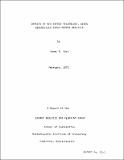| dc.contributor.author | Just, James Edward | |
| dc.date.accessioned | 2005-09-15T14:19:30Z | |
| dc.date.available | 2005-09-15T14:19:30Z | |
| dc.date.issued | 1973 | |
| dc.identifier.other | 03828844 | |
| dc.identifier.uri | http://hdl.handle.net/1721.1/27231 | |
| dc.description | Also issued as a Ph.D. thesis in the Dept. of Electrical Engineering, 1973 | en |
| dc.description.abstract | Traditional input-output analysis was modified to include air
pollution emissions, employment, and other accessory variables.
Engineering studies of high and low DTU coal gasification and
the gas turbine topping cycle were then utilized to incorporate
these new technologies into the 1980 input-output table
that was projected by the Bureau of Labor Statistics. These
two techniques are shown to be able to correct many previous
objections to input-output analysis and to have applicability
to a wide variety of practical problems.
A series of 1985 projections featuring high, medium and low growth of energy consumption
(both with and without the new technologies) were also made. Economic and environmental
impacts were then calculated for these alternative futures. The major conclusions are:
1. Total investment in general and capital good industries
in particular (primarily turbogenerator
manufacturers, boiler makers, and construction
equipment manufacturers) are quite sensitive to
energy use growth rates (especially electricity).
2. Introduction of high tu coal gasification will
aggravate the demand for investment funds and
introduction of the second generation gas turbine
topping cycle (with or without low Btu coal qasification)
will decrease the demand. These technologies
will have their major impacts on the industries
listed above.
3. Sliaht changes in the overall growth rates of total
personal consumption expenditures and government
spending result in large fluctuations in total
investment.
4. If high energy qrowth continues and if investment
is to remain within its historical limits as a per
centage of GNP, energy investment will become a
laraer and larqer part of total investment.
5. While interest rates are assumed to be the balancino
mechanism between supply of and demand for investment
funds, the very act of saving more money (which is
induced by hiqher interest rates) means that less can
be spend on consumption goods. This in turn lessens
the demand for investment funds because the qrowth
rates of consumption sectors are lovwer. This
indirect effect of interest rates on investment has
been little studied but may be quite important.
The policy implications of these results are also discussed. | en |
| dc.format.extent | 13208231 bytes | |
| dc.format.mimetype | application/pdf | |
| dc.language.iso | en_US | en |
| dc.publisher | MIT Energy Lab | en |
| dc.relation.ispartofseries | MIT-EL | en |
| dc.relation.ispartofseries | 73-001 | en |
| dc.subject | Economic forecasting | en |
| dc.subject | Investments | en |
| dc.subject | Power resources | en |
| dc.subject | Technology assessment | en |
| dc.title | Impacts of new energy technology using generalized input-output analysis | en |
| dc.type | Technical Report | en |
